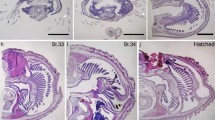Summary
Many organs ofViviparus viviparus were explanted into a culture medium of low osmotic pressure, adapted for fresh water molluscs. The development in vitro of the explants differed according to the particular organ. The best results were obtained with the heart, which was still contracting after 2 months in culture, and with the tentacle, which remained excitable for a period of 6 to 7 weeks. The central nervous system survived well for 18 to 20 days. The fragments of digestive gland died rapidly, in about 1 week.
Fragments of intestine retained a normal appearance for 2 weeks. The period of survival of male or female gonads was also 2 to 3 weeks. Vitellogenesis did not proceed very far in the ovary, but the young oocytes remained healthy. In the testis, only spermatogonia persisted and continued to divide during the culture period: further stages would appear to require a hormonal supplement.
Similar content being viewed by others
References
Bayne, C. J. 1968. Molluscan organ culture. Malacol. Rev. 1: 125–135.
Gomot, L. 1972. The organotypic culture of invertebrates other than insects. In: C. Vago (Ed.),Invertebrate Tissue Culture. Vol. 2. Academic Press, Inc., New York and London, pp. 41–136.
Benex, J. 1966. Les possibilités de la culture organotypique en milieu liquide dans l’étude des problèmes parasitaires. I. La culture organotypique en milieu liquide d’explants de Planorbes. Ann. Parasitol. Hum. Comp. 41: 351–378.
Hollande, E. 1968. Evolution des grains de sécrétion dans les cellules des glandes multifides d’Helix pomatia, maintenues en survie expérimentale. C. R. Acad. Sci. (Paris) 267: 1054–1057.
Wolff, E., and K. Haffen 1952. Sur une méthode de culture d’organes embryonnairesin vitro. Tex. Rep. Biol. Med. 10: 463–472.
Vianey-Liaud, M., and F. Lancastre 1968. Utilisation d’un milieu diphasique pour la culture organotypique d’explants d’Australorbis glabratus (Pulmoné Basommatophore). C. R. Acad. Sci. (Paris) 266: 1317–1319.
Streiff, W. 1967b. Etude endocrinologique du déterminisme du cycle sexuel chez un Mollusque hermaphrodite protandre Calyptraea sinensis L. III. Mise en évidence par culturein vitro de facteurs hormonaux conditionnant l’évolution de la gonade. Ann. Endocrinol. (Paris) 28: 641–656.
Gomot, L., and A. Guyard. 1968. La culture organotypique appliquée à l’endocrinologie d’un Mollusque Gastéropode Pulmoné:Helix aspersa Müll. Proc. 2nd Internat. Col. Invert. Tissue Culture, Milano 22: 31.
Lubet, P., and W. Streiff 1970. An experimental study of the effect of nerve ganglia on morphogenesis of the penis and on the genital activity ofCrepidula fornicata Phil. (Gastropod Mollusk). In: H. Lutz (Ed.),Invertebrate Organ Cultures. Vol. 2. Gordon & Breach, New York, London, Paris, pp. 135–152.
Choquet, M. 1971. Etude du cycle biologique et de l’inversion du sexe chezPatella vulgata L. (Mollusque Gastéropode Prosobranche). Gen. Comp. Endocrinol. 16: 59–73.
Guyard, A. 1971. Etude de la différenciation de l’ovotestis et des facteurs contrôlant l’orientation sexuelle de gonocytes de l’escargotHelix aspersa Müller. Thèse no. 56. Doc. Sc. nat., Besançon.
Guyard, A. 1967. Féminisation de la glande hermaphrodite juvénile d’Helix aspersa Müll associéein vitro au ganglion cérébroide d’escargot adulte ou de paludine femelle. C. R. Acad. Sci. (Paris) 265: 147–149.
Guyard, A. 1969. Elaboration d’un milieu synthétique enrichi destiné à la culture d’organes de Mollusques. C. R. Acad. Sci. (Paris), 268: 162–164.
Streiff, W. 1963. Survie en culturein vitro d’organes deCalyptraea sinensis L. (Mollusque Prosobranche). C. R. Acad. Sci. (Paris), 256: 292–294.
Holtfreter, J. 1931. Über die Aufzucht isolierter Teile des Amphibienkeimes. II. Züchtung von Keimen und Keimteilen in Salzlösung. Wilhelm Roux Arch. EntwMech. Org. 124: 404.
Benex, J. 1961. La survie d’explants de Planorbes (Australorbis glabratus) en milieu synthétique, antiseptique et nutritif. C. R. Acad. Sci. (Paris), 253: 734–736.
Benex, J. 1964. Sur la dédifférenciation des tentacules de Planorbes en survie: rôle de la présence d’éléments nerveux sur le retard de cette dédifférenciation. C. R. Acad. Sci. (Paris) 258: 2193–2196.
Streiff, W., J. Le Breton, and N. Silberzahn. 1970. Non spécificité des facteurs hormonaux responsables de la morphogèse et du cycle du tractus génital mâle chez les Mollusques Prosobranches. Ann. Endocrinol. (Paris) 31: 548–556.
Cheng, T. C., and R. J. Arndt. 1973. Maintenance of cells ofBiomphalaria glabrata (Mollusca) in vitro. J. Invertebr. Pathol. 22: 308–310.
Basch, P. F., and J. J. Di Conza 1973. Primary cultures of embryonic cells from the snailBiomphalaria glabrata. Am. J. Trop. Med. Hyg. 22: 805–813.
Author information
Authors and Affiliations
Rights and permissions
About this article
Cite this article
Griffond, B., Gomot, L. Cultivation in vitro of organs of the fresh water gastropod prosobranch molluscviviparus viviparus L. In Vitro 10, 206–215 (1974). https://doi.org/10.1007/BF02615234
Issue Date:
DOI: https://doi.org/10.1007/BF02615234




